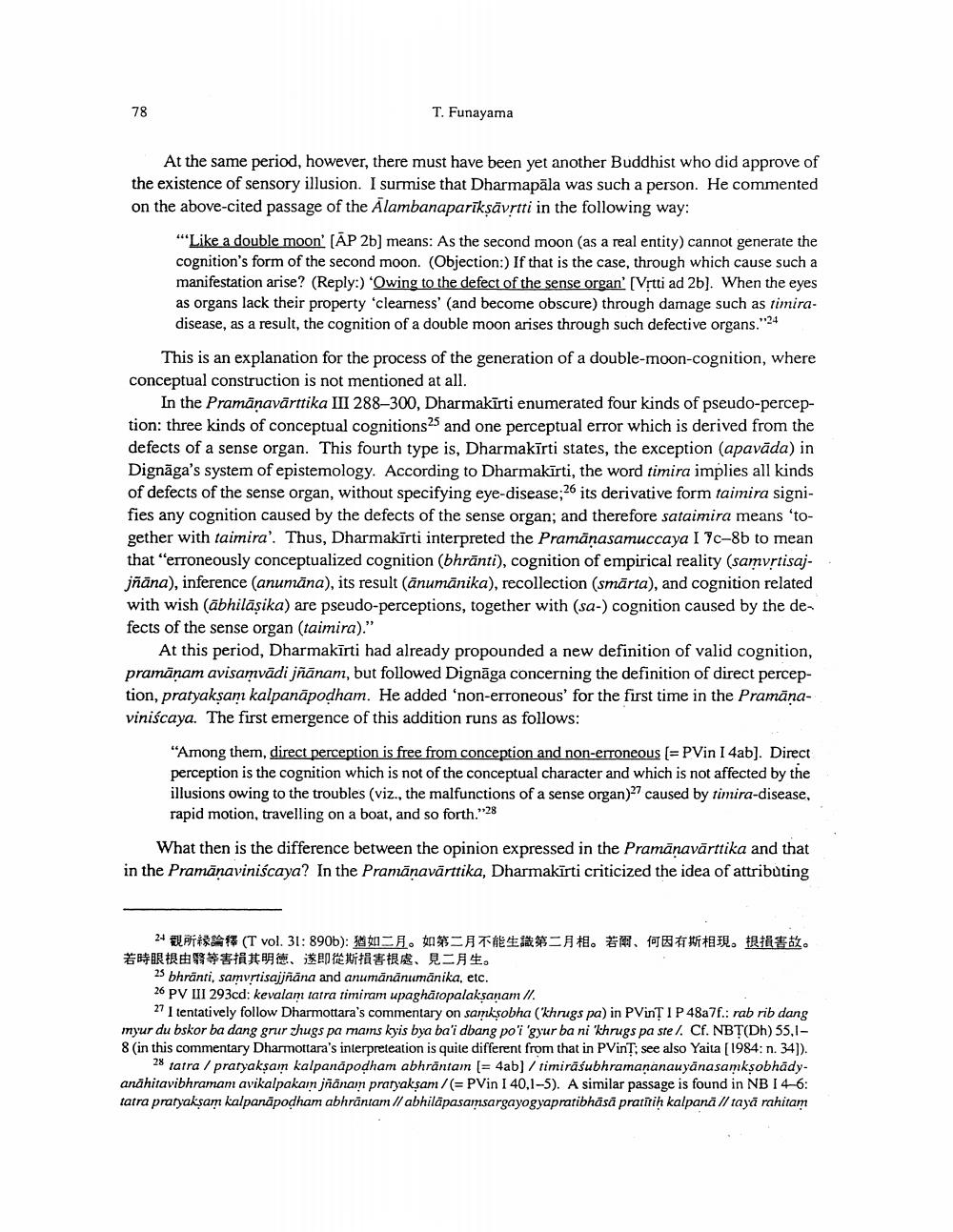________________
T. Funayama
At the same period, however, there must have been yet another Buddhist who did approve of the existence of sensory illusion. I surmise that Dharmapāla was such a person. He commented on the above-cited passage of the Alambanaparīkṣāvstti in the following way:
"Like a double moon' TĀP 2b] means: As the second moon (as a real entity) cannot generate the cognition's form of the second moon. (Objection:) If that is the case, through which cause such a manifestation arise? (Reply:) 'Owing to the defect of the sense organ(Vịtti ad 2b). When the eyes as organs lack their property 'clearness' (and become obscure) through damage such as timiradisease, as a result, the cognition of a double moon arises through such defective organs."
This is an explanation for the process of the generation of a double-moon-cognition, where conceptual construction is not mentioned at all.
In the Pramanavārttika III 288–300, Dharmakūrti enumerated four kinds of pseudo-perception: three kinds of conceptual cognitions and one perceptual error which is derived from the defects of a sense organ. This fourth type is, Dharmakīrti states, the exception (apavāda) in Dignāga's system of epistemology. According to Dharmakārti, the word timira implies all kinds of defects of the sense organ, without specifying eye-disease;26 its derivative form taimira signifies any cognition caused by the defects of the sense organ; and therefore sataimira means 'together with taimira'. Thus, Dharmakīrti interpreted the Pramānasamuccaya I 7c-8b to mean that "erroneously conceptualized cognition (bhrānti), cognition of empirical reality (samvrtisajjñāna), inference (anunāna), its result (ānumānika), recollection (smārta), and cognition related with wish (ābhilāşika) are pseudo-perceptions, together with (sa-) cognition caused by the defects of the sense organ (taimira)."
At this period, Dharmakīrti had already propounded a new definition of valid cognition, pramanam avisamvādi jñānam, but followed Dignāga concerning the definition of direct perception, pratyakşam kalpanāpodham. He added 'non-erroneous' for the first time in the Pramānaviniscaya. The first emergence of this addition runs as follows:
"Among them, direct perception is free from conception and non-erroneous (= PVin I 4ab). Direct perception is the cognition which is not of the conceptual character and which is not affected by the illusions owing to the troubles (viz., the malfunctions of a sense organ)” caused by timira-disease, rapid motion, travelling on a boat, and so forth.":28
What then is the difference between the opinion expressed in the Pramānavārttika and that in the Pramanaviniscaya? In the Pramānavārttika, Dharmakīti criticized the idea of attributing
24 V PÅ 1 (T vol. 31: 890b): A. # 97
9.
T
1 854. Nii R $i & Wi &
#. 25 bhränti, samvrtisajjnana and anumanănumānika, etc. 26 PV III 293cd: kevalam tatra timiram upaghätopalaksanam //.
27 I tentatively follow Dharmottara's commentary on samksobha ('khrugs pa) in PVinTIP 48a7f.: rab rib dang myur du bskor ba dang grur hugs pa mams kyis bya ba'i dbang po'i 'gyur ba ni 'khrugs pa stel. Cf. NBT(Dh) 55,18 (in this commentary Dharmottara's interpreteation is quite different from that in PVinT; see also Yaita [1984: n. 34]).
28 tatra / pratyakşam kalpanāpodham abhräntam (= 4ab] / timirāśubhramananauyānasamksobhädyanahitavibhramam avikalpakam jñānam pratyaksam/(= PVin I 40,1-5). A similar passage is found in NB I 4–6: tatra pratyakşam kalpanapodham abhrāntam // abhilāpasamsargayogyapratibhāså pratitih kalpanā // tayā rahitam




